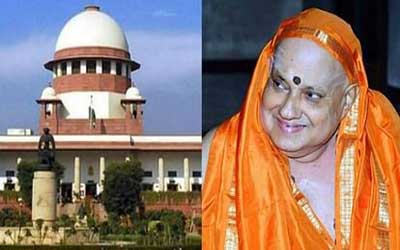Date: 26/04/2023
Relevance: GS-2: Constitution of India - historical underpinnings, evolution, features, amendments, significant provisions and basic structure.
Key Phrases: Minerva Mills Ltd. v. Union of India, S. R. Bommai v. Union of India, Vishaka v. State of Rajasthan, Rule of law, Supremacy of the Constitution, Fundamental Rights.
Context:
- April 24, 2023, marked the 50-year anniversary of this landmark decision of the Supreme Court that paved the way for several other judgments of constitutional importance that have shaped the current constitutional landscape of the country.
What was the Judgement?
- The case was heard by a full court of 13 judges, the largest bench ever, and the judgment was delivered in a 7:6 majority.
- The case was filed by Swami Kesavananda Bharati, the senior plaintiff and head of the Edneer Mutt in Kasaragod district of Kerala, who challenged the Kerala government's attempts, through two land reform acts, to impose restrictions on the management of the Mutt’s property.
- The Kesavananda Bharati judgment held that provisions of the Indian Constitution can be amended by Parliament in order to fulfill its socio-economic obligations.
- However, more importantly, the judgment also held that the basic structure of the Constitution cannot be altered by Parliament no matter what.
- The basic structure doctrine means that there are certain fundamental
features of the Constitution that cannot be amended by Parliament, such as -
- Supremacy of the Constitution
- The Federal character of the Constitution
- The Separation of powers between the Legislature, the executive, and the judiciary
- The Protection of Fundamental Rights
- Balance between Fundamental Rights and Directives Principles
- Secularism
Was there any idea of “Basic Structure” before KESHAVANANDA BHARATI Case?
- During the hearing of Sajjan Singh Case 1965, Mudholkar J. (in 1964) talked of basic features in the Constitution and opined that it should be given permanency.
- Shortly thereafter in February 1965, while on a visit to India, a German Professor Henry Conrad delivered a lecture on "Implied Limitations of the Amending Power" to the Law Faculty of the Banaras Hindu University.
- The argument of implied limitations had been advanced at the Bar by M. K. Nambyar, one of India's leading constitutional lawyers. He presented it before the Supreme Court in Golak Nath's Case 1967, but the doctrine of any implied limitations on Parliament's power to amend the Constitution was not accepted.
- The majority felt that "there is considerable force in this argument" but thought it unnecessary to pronounce on it. "This question may arise for consideration only if Parliament seeks to destroy the structure of the Constitution embodied in provisions other than in Part III of the Constitution."
What was the KESHAVANANDA BHARATI Case?
- Kesavananda Bharati was a seer from the Smarta tradition of Advaita
Vedanta.
- In February 1970, Kesvananda Bharati was compelled to take the Kerala Government to court, challenging the 1969 Land Reforms enacted by the then C. Achuta Menon government that had affected his Mutt.
- Through the land reforms, the government took away a large chunk of Edneer Mutt’s property, causing it severe financial difficulties.
- Bharati filed a writ petition in the Supreme Court challenging the land reforms.
- Along with his lawyer Nani Palkhivala, Kesvananda Bharati argued that the new laws violated his fundamental rights, specifically his fundamental right to religion (Article 25), freedom of religious denomination (Article 26), and the right to property (Article 31).
The Keshavananda Bharati case paved the way for several other judgments of constitutional importance:
- Indira Nehru Gandhi v. Raj Narain (1975): In this case, the Supreme Court held that the right to vote was a fundamental right and that the election of a Prime Minister could be challenged in court.
- Maneka Gandhi v. Union of India (1978): In this case, the Supreme Court expanded the scope of the right to life and personal liberty guaranteed by Article 21 of the Constitution and held that the procedure established by law must be reasonable, just, and fair.
- Minerva Mills Ltd. v. Union of India (1980): In this case, the Supreme Court upheld the principle of basic structure and struck down parts of the 42nd Amendment to the Constitution, which had given Parliament the power to amend any part of the Constitution without judicial review.
- S. R. Bommai v. Union of India (1994): In this case, the Supreme Court laid down guidelines for the exercise of the President's power to dismiss state governments and imposed restrictions on the use of Article 356 of the Constitution, which deals with the imposition of President's Rule.
- Vishaka v. State of Rajasthan (1997): In this case, the Supreme Court recognized sexual harassment at the workplace as a violation of a woman's fundamental right to equality and laid down guidelines to prevent such harassment.
- Aadhaar case (Justice K.S. Puttaswamy (Retd.) v. Union of India, 2018): Here the Supreme Court held that the Aadhaar Act was constitutional but struck down several provisions that violated the basic structure of the Constitution, such as mandatory linking of Aadhaar with bank accounts and mobile numbers.
- Sabarimala temple case (Indian Young Lawyers Association v. State of Kerala, 2018): Here the Supreme Court held that the ban on entry of women of a certain age group to the Sabarimala temple in Kerala violated the basic structure of the Constitution, which includes the principles of equality and non-discrimination.
Conclusion:
- The Keshavananda Bharti case judgment is a testament to the strength and resilience of the Indian Constitution and its ability to adapt to changing circumstances while retaining its core values.
- It is a landmark moment in the country's legal history, and its impact will continue to be felt for generations to come.
Source: The Indian Express , India Today
Mains Question:
Q. In the Keshavananda Bharati case (1973), the Supreme Court propounded the theory of the 'basic structure' of the Constitution. What do you understand by the 'basic structure' doctrine? (150 Words).







